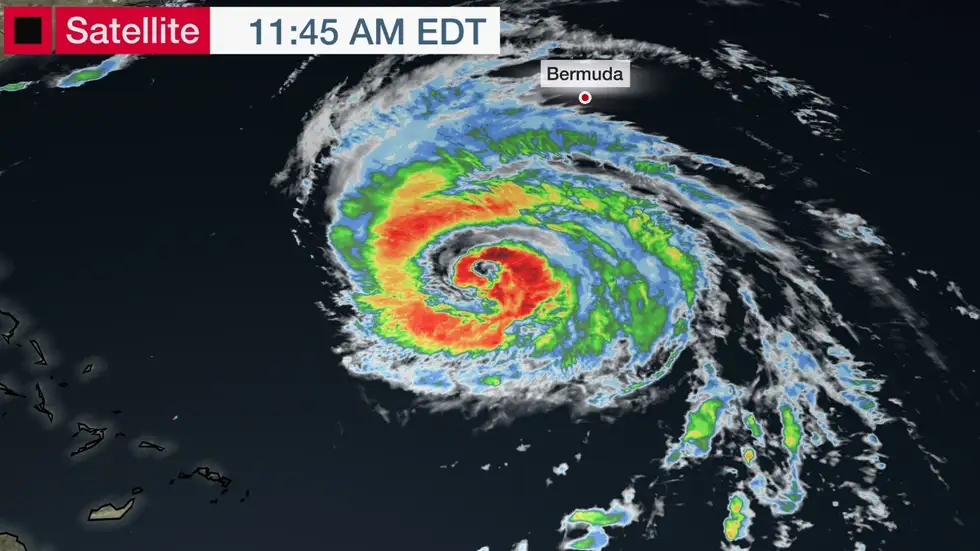At a Glance
- Lee is a large and powerful hurricane and has begun to make its northward turn.
- Rain, strong winds and high surf will impact parts of Bermuda by early Thursday.
- Lee will bring wind, rain and coastal flooding impacts to eastern New England and Atlantic Canada this weekend.
- Dangerous high surf, rip currents and coastal flooding are likely along the East Coast throughout this week.
Hurricane Lee has begun its trek northward and its large size means the storm is increasingly likely to affect eastern New England in addition to Atlantic Canada and Bermuda with strong winds, soaking rain and coastal flooding over the coming days.
Swells generated by Lee are already producing rip currents and high surf along much East Coast.
What’s the latest on Lee? Lee is a large and powerful hurricane centered several hundred miles south of Bermuda and is moving to the north-northwest.
A tropical storm warning is in effect for Bermuda. Watches could be issued later today or tonight for eastern New England and Atlantic Canada, the National Hurricane Center noted on Wednesday morning.
Lee remains a major hurricane, Category 3, but that’s not as much of an attention-grabber as its size.
Hurricane-force winds extend outward up to 115 miles from the center and tropical-storm-force winds extend out up to 240 miles. That’s a large wind field for a hurricane.
Here’s where Lee will go the next few days: The forecast path for Lee has become more certain with the hurricane expected to track west of Bermuda late this week and then toward the Gulf of Maine, or the waters near eastern New England and western Atlantic Canada, by Saturday.
Lee’s peak winds are expected to begin stepping down Wednesday into Thursday. That’s because it will encounter cooler water, partly induced by upwelling from Hurricane Franklin and the remnants of Idalia, drier air, higher wind shear and eventually will also pass north of the warm Gulf Stream into even cooler water.
Even though the hurricane will weaken, the size of its winds, or how much area they cover, is expected to grow even more, which means impacts will be felt in a larger area.
Here’s a look at potential impacts in New England, Atlantic Canada and Bermuda: There is still uncertainty in the exact details, but its increasingly likely eastern New England will see wind, rain, high surf and coastal flooding impacts from Lee in addition to Atlantic Canada and Bermuda.
As alluded to earlier, the storm will also grow in size, which means impacts will extend far from where its center tracks.
With that in mind, here’s a general overview of what we know about possible impacts right now. Check back with us as more details will be added soon.
Eastern New England: Rain and wind impacts could arrive by late Friday or Saturday, but the extent of those impacts will be determined by the exact path of Lee. There is the possibility that Lee’s winds in combination with saturated soils could down trees and knock out power in some areas.
Coastal flooding and large, pounding surf are also likely impacts from coastal Massachusetts to Maine.
Atlantic Canada: Much like eastern New England, Nova Scotia and New Brunswick will likely see heavy rain, strong winds, high surf and coastal flooding develop by Friday night or Saturday.
Bermuda: Rainfall, tropical-storm-force winds and high surf will impact the archipelago by early Thursday.
Interests in all of the above-mentioned locations should continue to monitor Lee’s forecast closely for potential changes ahead.
Dangerous surf, rip currents will occur along most of the East Coast: Swells generated by Lee are already affecting a large part of the East Coast. That means high surf, rip currents, coastal flooding and even beach erosion could occur along parts of the coast.
Keep this in mind if you live near or plan to head to the Atlantic beaches this week. Stay out of the water, especially if red flags are flying at the beach.
Lee’s History So Far
Lee became the 13th storm of the 2023 Atlantic hurricane season last Tuesday afternoon and the fourth hurricane of the season last Wednesday afternoon. That was over a week ahead of the average fourth hurricane pace of Sept. 16, according to National Hurricane Center data.
Lee then underwent explosive rapid intensification, going from a Category 1 to a Category 5 hurricane in just 18 hours last Thursday. Only three other Atlantic hurricanes since 1982 had seen their winds increase by 80 mph in 24 hours or less since 1982, most recently Matthew in 2016. It was the fastest 24-hour intensification anywhere in the Atlantic Basin outside the Gulf of Mexico and Caribbean Sea in 41 years, according to Kieran Bhatia, a Princeton University scientist.
Source: https://weather.com/storms/hurricane/news/2023-09-12-hurricane-lee-forecast-northeast-canada-bermuda?cm_ven=hp-slot-1


